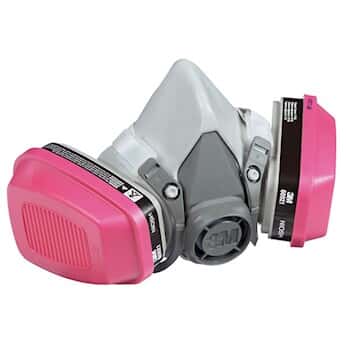If you are working with any type of harmful material, whether that be in solid, liquid or gas form, then protection is a must. There are various types of PPE that you might need to wear but perhaps the most crucial is the respirator.
These pieces of equipment offer varying levels of protection depending on the environment you are working with. So, what are the three types of respirators and what are they used for?
Respirators come in three styles; the dust mask, the elastomeric half mask and the full face piece. Each of these can also come in a powered or unpowered form so it’s important to weigh up your needs and choose accordingly.
In this guide, we will be looking at the different types of respirators a little more closely. We’ll also be explaining which one you might need in different situations.
What Is A Respirator?
A respirator is a piece of personal protective equipment that is designed to stop the user from breathing in dangerous particles. They are fitted with a filter which takes out a significant amount of harmful particles from the air. When you breathe in, there’s far less chance of you inhaling anything that could cause health problems.
For more severe environments, there are also pieces of breathing apparatus. These require a separate source of air such as a compressor or cylinder to function.
For both types of equipment, you have a choice between two further types. There are tight fitting face pieces which create a strong seal around your face. In order to wear these, the skin should be clean shaven. If you have a beard, it is difficult to create a seal which will lessen your protection.
Alternatively, there are loose fitting respirators which usually come in the form of a helmet or a hood. These can be worn by those with facial hair and are always powered.
What Are The Different Types Of Respirators?
Whether you are using a powered or unpowered respirator, you have a choice between three different types of mask. These are further explained below.
Dust Masks
A dust mask offers the lowest level of protection and is a disposable piece of equipment. They’re usually reserved for use in environments where there are non-toxic fumes and dust. It is important not to confuse a dust mask with an N95 respirator which is a different piece of equipment.
Half Masks
A half mask, as the name suggests, covers half of the face including the mouth and nose. These are reusable devices that have interchangeable filters. These filters come in different levels of protection and it’s important to choose the right one for the environment you will be working in.
Full Face Pieces
The full facepiece is similar to the half mask in that it also uses filters. However, in this instance, the mask covers the entire face. One of the biggest benefits is that, since they cover the eyes, this often removes the need for goggles. They’re pretty diverse in that they offer protection from a wide range of gases, fumes, dust, and other particles.
What Mask Protects Against Chemical And Biological Agents?
A respirator is a type of RPE that provides protection from a range of contaminants. This includes chemicals and harmful biological materials such as viruses.
If you are going to be exposed to harmful chemicals then you will require a chemical cartridge in your respirator. These air purifying masks remove harmful particles from the air before you breathe it in and offer a good level of protection.
Similar equipment is also suitable for use around biological hazards. The wearer must ensure that the filter is capable of filtering out microscopic particles to gain the best protection.
What Does A Full Face Respirator Protect You From?
A full face respirator offers full protection against a variety of contaminants. They’re ideal for fogs, mists, fumes, gases, solid particles and biological hazards. However, it is important to make sure you have the correct filter or cartridge.
As well as this, a full face respirator provides you with eye protection. Some chemicals and fumes can be irritating to the eyes and require the use of goggles. But when wearing a full face respirator, you have all types of protection in one.
How To Choose The Right Respirator
While understanding the different types of respirator goes a long way in helping you decide which is best, there is a little more to making the right decision.
For starters, if you are going to wear a respirator, your employer, or whoever is responsible for you, should ensure that you are medically fit to use this type of PPE. Moreover, you should be provided with annual training to make sure you are familiar with how the equipment works. At this time, you must also undergo a face fit test to check that the mask forms the required seal.
During your fit test, your face shape, size and structure will all be examined. Through this, a suitable make and model of mask can be chosen. After this, you should always stick with the same mask so you know it provides you with the utmost protection.
Recent Article: Can You Fit A Carpet With Furniture In The Room
Conclusion
Lots of people are working in hazardous environments. They may be exposed to harmful chemicals, gases and even biological hazards. While this does pose a risk to health, using a respirator will drastically reduce exposure. There are three main types of respirator; dust masks, half masks and full face pieces. Assessing your needs and the risks you’ll be exposed to will help you make the right decision.

1 thought on “What Are The Three Types Of Respirators”